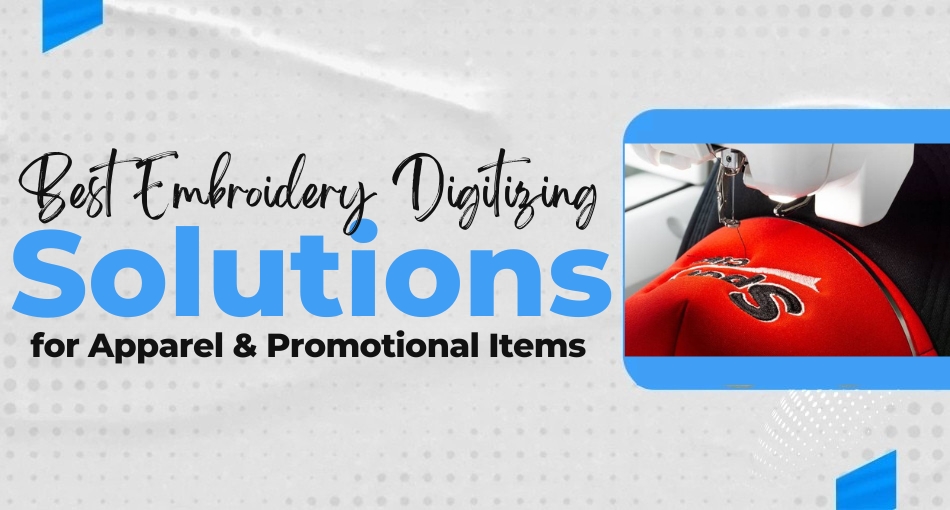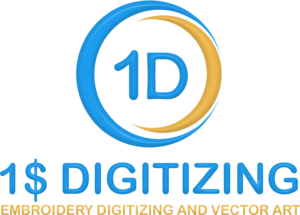Great embroidery doesn’t just happen. It all starts with a perfect digital file. This guide is your new best friend. We’ll show you how to find the right digitizing solutions. Your designs will look amazing on any fabric. Let’s boost your quality and make things run smoother.
What’s the Big Deal with Digitizing Anyway?
So, you have a cool logo for a polo shirt. Or maybe a neat design for a hat. How does it get stitched out? An embroidery machine needs a special road map. That road map is what we call a digitized file.
Digitizing is the art of turning a regular image into a stitch file. Think of converting a JPG or PNG into a. DST or .PES file. Your machine can finally understand these instructions. This isn’t a simple click of a button. A real person, a digitizer, has to plot everything out. They decide where every single stitch goes. They choose the stitch type and direction. They also control how dense the stitches are.
A good digitizer thinks about the fabric. They consider the thread thickness. They aim for a certain texture in the final look. The quality of this digital plan is everything. A bad file can cause all sorts of problems. You might see fabric puckering up. Stitches could have ugly gaps. The whole design might just look flat and cheap. For any real embroidery business, getting this step right is a must. You either learn it or you hire a pro.
The Two Roads: DIY or Hire a Pro?
You have two main choices for getting designs digitized. You can do it yourself with special software. Or you can pay a professional service to handle it. Each path has its own set of pros and cons. Let’s break them down.
1. Going In-House with Digitizing Software
You can take charge of digitizing on your own. This means buying software to do the job. Programs like Wilcom Hatch or Brilliance are popular. This route gives you ultimate control.
The Good Stuff:
- You’re in control. Tweak every little detail. Make it exactly how you want it.
- It can be faster. Once you know the software, you work on your own time. No waiting for someone else.
- Saves money on big jobs. Does your embroidery business do tons of custom work? The software cost pays off over time.
The Not-So-Good Stuff:
- It’s hard to learn. Digitizing software is complicated. It takes a lot of time and practice to get good.
- It costs a lot upfront. Good software isn’t cheap. It can set you back hundreds or even thousands.
- It eats up your time. A complex design can take hours. That’s time away from other important tasks.
2. Outsourcing to a Digitizing Service
For lots of businesses, hiring out is the smarter move. You just send your artwork to a company that only does digitizing. It’s a popular and practical choice for a reason.
The Good Stuff:
- You get expert quality. These folks are pros. They know all the tricks for different fabrics.
- It saves you so much time. You can focus on growing your business. Let them handle the technical stuff.
- It’s cheaper for smaller volumes. Paying per design is affordable. Especially if you’re just starting out.
- You get consistent results. Good services deliver the same quality every time. That’s key for happy clients.
The Not-So-Good Stuff:
- You have less direct control. You have to trust your partner to do it right.
- You have to wait. Turnaround is usually fast, maybe 24 hours. But you’re still on their schedule.
- Finding the right one takes work. There are tons of options out there. Not all of them are great.
How to Pick the Best Embroidery Digitizing Services
Finding a good partner for outsourcing is a game-changer. A great service is like adding an expert to your team. They make sure every project starts off right. Here’s what you should look for when choosing one.
- Check out their past work. Don’t just trust their website copy. Look at their portfolio. Are the stitches clean? Is the detail nice and sharp? Do they show work on tricky fabrics like fleece or performance gear?
- Ask for a test run. Many of the best embroidery digitizing services offer a free or cheap trial. This is the best way to judge them. Send them a logo that’s not too simple. Then stitch it out. See how it looks on real fabric.
- Know their turnaround time. How fast can you get a file back? Most great services can do it in 24 hours. Speed is nice, but quality must come first.
- Figure out their pricing. Do they charge by stitch count? Or is it a simple flat rate? Flat rates are usually easier to manage. You’ll know exactly what to charge your own customers. Be careful of super cheap prices. They often mean low-quality, auto-digitized junk.
- Ask about edits. What if the file isn’t perfect? A solid partner will offer free revisions. This shows they care about the final product. It means they stand by their work.
- Confirm your file formats. Make sure they can send the right file type. Your machine needs a specific format like .DST, .PES, or .JEF. A pro service can handle any major machine brand.
Pro Tips for Flawless Custom Embroidery Digitizing
Getting the file right starts with you. Whether you do it yourself or outsource, your prep work matters. A little effort at the start saves big headaches later.
- Always start with good artwork. It’s simple: garbage in, garbage out. A clean vector file is best. That means an .AI, .EPS, or .SVG. If you only have a JPG or PNG, make sure it’s high-resolution. A fuzzy image forces the digitizer to guess.
- Tell them about the fabric. Always let your digitizer know what it’s being stitched on. A structured cap needs different settings than a stretchy polo. Thick fleece is a whole other challenge.
- Be clear about the size. Give them the exact width and height. You can’t just resize a digitized file later. A 4-inch logo won’t scale to a 10-inch jacket back. It needs to be re-digitized from scratch.
- Keep designs simple enough. Not everything from a print design works with thread. Tiny text and soft gradients get lost. Work with clients to clean up their art for embroidery. Focus on bold lines and clear shapes.
- Watch your text. Letters need to be big enough to read. A good rule is at least a quarter-inch tall. Sans-serif fonts also tend to stitch out cleaner than fancy serif fonts.
Your Partner in Awesome Embroidery
The right digitizing solution is your secret weapon. It’s the foundation of your whole embroidery game. You can learn the skill yourself. Or you can team up with an expert. Either way, investing in quality digitizing always pays off. You’ll have fewer mistakes. You’ll waste less material. And you’ll create amazing products that make clients happy.
When you focus on clean art and clear communication, you win. Vetting your partners sets you up for success. For any shop that needs a reliable pro for custom embroidery digitizing, a service is a great move. Companies like 1dollardigitizing deliver a mix of quality, speed, and great pricing. They can help you level up your work and streamline your process.




